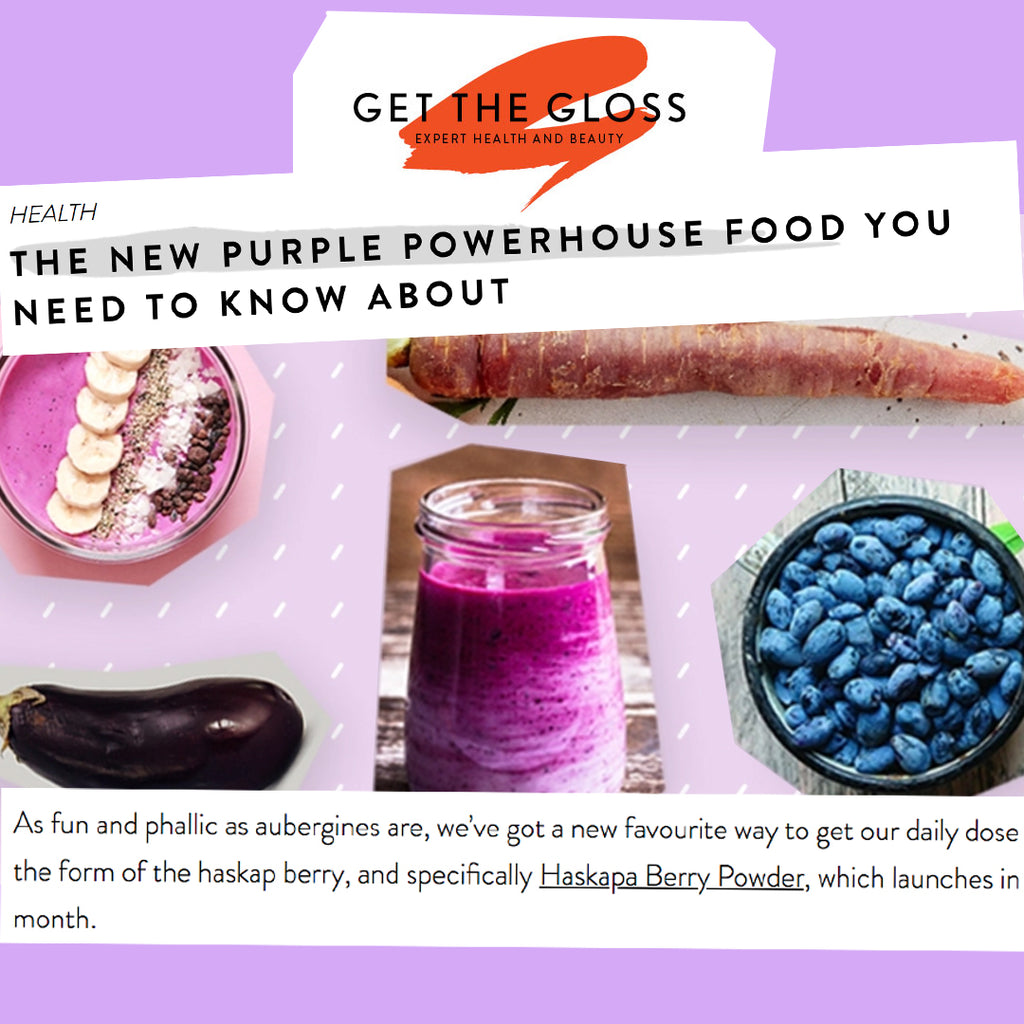IN THE PRESS - GET THE GLOSS
We're delighted to see Haskapa in this week's Get the Gloss 'Purple Reigns: The new purple powerhouse food you need to know about.'

WE ALL KNOW WE NEED TO EAT THE RAINBOW, BUT WHY ARE PURPLE FOODS SO GOOD FOR US AND WHAT ON EARTH ARE HASKAP BERRIES?
Thanks to an oft-used emoji, aubergines are more likely to crop up in your WhatsApp chats than on your shopping list, but there’s more to that cheeky guy than saucy texts. Along with other purple foods, including red cabbage, purple sprouting and the haskap berry (a superfood from Japan, Russia, Canada - more on that later…) aubergines are packed full of a particular type of antioxidant called anthocyanins. These are found in the pigments (flavonoids) that give purple fruits their rich colour. And it's also the bit that gives purple foods their superior nutritional punch, making them anti-inflammatory and helping to protect against DNA damage.
WHAT DO ANTHOCYANINS ACTUALLY DO?
Anthocyanins can help to fight the flu, combat inflammation, lower blood pressure and even improve muscle function. They have even been linked to preventing dementia and improving cardiovascular health.
“Anthocyanins are antioxidants that help protect our body from oxidative stress,” confirms nutritionist Sophie Langley who is accredited by the Association of Nutrition and works for health brand Exante.
“Oxidative stress is an imbalance between free radicals (bad things – think toxins) and antioxidants (good things) in your body. Free radicals react with other molecules in your cells, causing direct damage to DNA possibly leading to cancer and dementia. Eating a sufficient amount of antioxidants helps fight the free radicals, bringing your body into a balance and reducing oxidative stress.”
Anthocyanins also have a range of health-promoting effects including being anti-inflammatory (helping protect you from chronic disease), neuroprotective (supporting and energising your brain), cardioprotective and anti-diabetic, so it’s no wonder the nutritional world is taking them seriously.
WHICH FOODS CONTAIN ANTHOCYANINS?
Purple vegetables are often healthier than their non-purple counter-parts. Purple potatoes have four times as many antioxidants than normal potatoes while purple carrots have twice a much alpha and beta-carotene (good for eye health) as orange carrots.
Red cabbage is something of a powerhouse (as well as being cheap and gown in the UK) with 36 different types of antioxidants. It’s been shown to have six to eight times more vitamin C than green cabbage too. Aubergines, purple sprouting, blueberries, dark grapes, red onions, blackberries all count too.
What about beetroot? The deep purple colour actually comes from plant chemicals called betalains, rather than anthocyanins, but they do still have antioxidant and anti-inflammatory properties (as well as making your pee pink).
And then there are haskap berries...
HELLO TO THE HASKAP BERRY

As fun and phallic as aubergines are, we’ve got a new favourite way to get our daily dose of anthocyanins, in the form of the haskap berry, and specifically Haskapa Berry Powder, which launches in the UK this month.
Native to northern hemisphere countries including Canada, Japan and Russia, the haskap is a double skinned berry with a vibrant purple/blue colour and crimson skin, which tastes refreshingly zesty, somehow managing to be both tangy and sweet.
Haskap berries are incredibly high in a mix of antioxidants and anthocyanins, with eight times more anthocyanins and three times more antioxidants than blueberries – the indigenous Ainu people of northern Japan knew the haskap berry as the berry of long life and good eyesight
As haskap berries aren’t widely available in the UK, Haskapa Berry powder is your way in. Made from berries grown in Canada by a husband and wife team, adding a scoop to your porridge, smoothie or baking not only makes your food a whole lot prettier but is an easy way to get your daily dose of these miracle-working berries.

